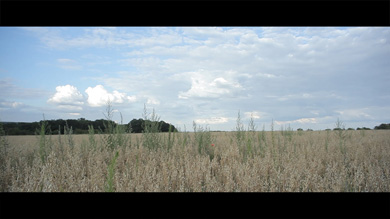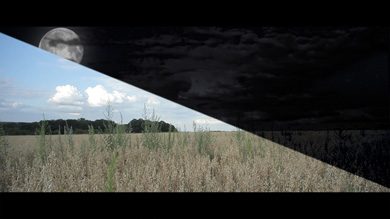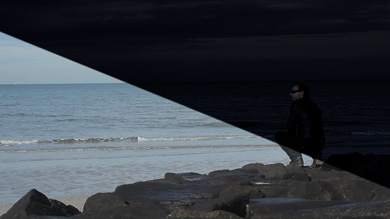
|
Special effect “Day for
Night” (nuit américaine) :
from origins to the present “Day for Night” is a film technique which is known to film the day an action that must be perceived by the viewer as taking place at night. The advantages of this technique (this "trick") are : - The night shoots are usually much more expensive (lighting, significant additional cost of labor, …). - Some night shoots are prohibited : for example, many countries prohibit shooting at night with children (France, for instance) - The quality of night takes are often poor (or if they are not, it may be very expensive) : when the film or the digital image sensor receives little light, then "SNR" is poor, which reveals the silver grains in the case of a chemical film, and the electronic noise in the case of a digital sensor. If the chemical film grain can sometimes be a desired effect (by the directors), the electonic noise is rarely compatible with the expectations of art (except in special cases : simulation of surveillance cameras, simulation of military light amplification set, and other cases ... where poor image quality makes sense in the story told by the film). - In theory, a day shooting provides more information (inside images) and then one can choose what information is retained or modified, either to go for realism (nights 100% likely) or to the aesthetic (Augmented Reality: conservation of information that we would not see normally at night, but that the director finds aesthetic). The movie industry (especially in the USA) developed very early “day for night” methods. Historical method before the advent of digital technology : day for night in the shooting
One can add a polarizing filter which eliminates some glare from the sun. and decreases the amount of light received by the film or by the sensor (thus contributing to the under exposure ). However, despite the precautions taken during the filming, it is usually possible to detect this kind of trickery : the brightness of the sky, reflections and shadows are often clues that reveal the special effects and make the fake night unrealistic. This imposes strong constraints on the framing when shooting (you shouldn’t see the sky for example), but the cast shadows can still often easily show that this is actually a daytime shooting. In order to erase shadows, one then prefers overcast weather. Other methods using infrared film were sometimes used even in the 80’s to simulate night (in a small range of infrared wavelength, the sky appears black, at least until you look in the opposite direction of the sun, and the skin of the actors appears white). But this method produces very noisy images, even for use in animated masks, and the result is actually quite far from what one would see at night. Regular digital calibration methods The generalization of the use of digital media has opened the door to other approaches to achieve the day for night effect (during post production). The video calibration machines and softwares are capable, within certain limits, to specifically address the different hues, saturation and luminance of the digital images. Targeted modifications of hue, saturation and luminance, are usually applied to give movies a unique ambiant visual atmosphere, in order to : - Strengthen the film's message - Provide a special aesthetic This digital calibration post production phase took the place of the chemical treatments of silver films (treatments that aimed to bring out some colors,... example : Technicolor). One can visualize the visual mood of a film by using, for example, “movie barcodes” : one compresses each frame of a film on a single column. You can then realize that the atmosphere varies greatly from one film to another : examples:
No country for old men (2007) :
Lost in translation (2003) :
Speed racer (2008) :
Predators (2010) :
In the mood for love (2000) :
The matrix (1999) :
NB: To find the movie barcode of your favorite film : http://moviebarcode.tumblr.com/page/1 The hardest part is then to darken the sky in order to make it less bright than the rest of the scene, and instead, keep actors faces clear enough that they are readily interpretable by the viewer. For this it is necessary to automatically detect these elements. Sky detection should be easy if the shooting is made under uniform blue sky; then darkening of the blue hue is darkening of the sky. This method makes it possible, contrary to historical approaches using filter and under exposure, to keep the sky in the framing. But beware, it often happens that the blue sky actually covers a wide range of brightnesses and colors that make it difficult to isolate, even with modern calibration tools. And in the end remains this “bright sky impressions” that spoil the day for night effect. Filming under a blue sky has the disadvantage of casting shadows : then umbrellas and sun visors are used. But it implie strong contraints on the camera movements. To remove the shadows, one can operate a shooting on overcast days. But in such a case, the bright white clouds and gray skies are not usually recognizable (in terms of hue) by calibration machines. Clouds (though these so frequent in our Euopean skies) are causing a lot of Day for Night failed effects : reverse video on the clouds that give strange results in the sky, iridescence of clouds contrours; ... etc. In the case of actors faces, difficulty comes in three main points: - The inter-personal variability : human beings do not all have the same skin color, - The three-dimensional shape of the head that generates light reflections and shadows that move with the movements of the actor, - The sharp change in color of the skin of the same individual depending on white balance. It is extremely rare that a simple template of hue, saturation, luminance can isolate a face on the whole duration of a scene. In conclusion, Day for Night effect is finally a rather difficult task that may bring constraints on the shooting in a manner that is inconsistent with the desire for artistic expression of the film director (see the sky in the frame or not, prohibit panoramic camera movement, ... ). New solution : advanced method calibration as a special effect The NEXYAD company has
developed (initially for applications in
satellite photogrammetry) unique image processing algorithms that can
target : - Hues - Saturation levels - Luminance levels - Textures - Apparent motions By combining these pre calculated elements, one can automatically isolate almost any part of the image: example: "the blue colors, very saturated, medium textured, rather bright, with little apparent movement" ... etc. This new technique can separate a blue sea from a blue sky, for instance. It allows to detect the sky and keep the clouds – if wanted – to make the clouds transparent and then replace the sky by a starry night with the moon (that will appear to be behind the clouds), etc. ... Examples of Day for Night renders : A - Le Havre (images NEXYAD):  (When you click on the image, it launches the film)  (When you click on the image, it launches the film)  (When you click on the image, it launches the film) In this sequence, we choose to keep the highlights textured white to push and create an illusion of urban lighting, the sky was darkened a little more than the sea, the clouds are preserved, a tracking is performed to add stars in the sky behind the clouds. Similarly, a reflection of the light is added into the sea. On this test, for purely aesthetic reasons, we kept the reds and ochres rather saturated. B - the wheat fields (images ALCATRAZ Production):  (When you click on the image, it launches the film)  (When you click on the image, it launches the film)  (When you click on the image, it launches the film) In this example, the clouds are kept in the sky, a tracking is performed to add the stars and the moon behind the clouds made transparent. C - man on rocks facing the sea (images NEXYAD):  (When you click on the image, it launches the film)  (When you click on the image, it launches the film)  (When you click on the image, it launches the film) In this example, everything is stained and darkened, but the person's face is left visible, and a starry sky is added behind the clouds made transparent. Conclusion :
NB: the shadows are detected and can be softened to become compatible with a feeling of night (so shootings on sunny days are OK). The light fitting can be done in post production. To a considerable extent, the sky fitting can also be done in post production because it is easy to replace the true sky by a starry sky. The shooting schedule of recommendations is basic (no white parts burned, etc.). In the case of particularly complex shootings (complex movements of cameras and actors, ...) NEXYAD dispatch a team to advocate on the set of simple technical solutions (avoid flares, avoid the cons far, except for very specific desired effects, etc ...). The use of this new method (provided by NEXYAD) is not restricted to Day for Night effect, since it allows quite any type of image rendering on the basis of almost any kind of rush: it is entirely appropriate for achieving sophisticated calibration (eg The Matrix, 300, ...) with a smaller budget. The special case of Day for Night is still interesting, as it allows to demonstrate the potential of the approach, where other methods provide very restrictive or ineffective solutions (or extremely costly ). For more information, contact NEXYAD: contact@nexyad.net |
|